
MAY CONTAIN NUTS

Search Shorpy
SHORPY ART

Framed or unframed, desk size to sofa size, printed by us in Arizona and Alabama since 2007. Explore now.
Join and Share
Ad-Free Shorpy
Shorpy is funded by you. Patreon contributors get an ad-free experience.
Learn more.

Recent comments
- Treescaping
- +112
- Rear View
- Way in the back --
- Button It Up
- And with an eye on the time ...
- Working in an enclosed ashtray
- Rear View Mirror?
- Tobacco cam
- Basic fact I learned only later in life
- Put a Lid on it!
- Pinstripes in the Tower
- Sound enhancement
- 3438 in '38
- Second Career
- Their days are numbered
- Only the Sensor
- Train control mechanism
- Rarest of the Rare?? & Classy 3400 Class
- Control Mechanism
- Those standpipes
- Wrenches
- International D-40 I believe
- Job prospects
- You had me at Train
- Land of the free
- Broad-Exchange Bldg
- Parking innovation
- The old block
- "Peck turned a sweet propeller"
Member Photos
The Shorpy
Printporium
Printporium
Search Shorpy
Search results -- 30 results per page
- This Old New House: 1900
- ... butterflies by day and fireflies in the millions by night. One of my neighbors does goats, while another does llamas.
Re: ... Posted by Dave - 03/03/2016 - 4:33pm -
![This Old New House: 1900 From around 1900 we bring you someone's new house in the vicinity of Stafford, Connecticut. Fancy millwork abounds! 5x8 glass negative. View full size.
That is a beautiful home... but it looks to me like the owner should invest in a lawn mower.
[He's on his way to pick up a scythe at Home Depot. - Dave]
Beautiful house, butMy first reaction was, "Wow, would I hate to have to paint that baby!"
Gingerbread Kit? Looks like the sort of house you could order from the Sears catalog:
Lawn CareOr they could be out getting a couple of goats.
It Never Rains in Connecticut!So no need for gutters or downspouts.
First, Second, and Third Reaction, and CountingIn my last neighborhood of some 25 years, I had a neighbor who had one of those 3-story Victorian things all covered in gingerbread. When I first moved there, the house was merely 2-color. About ten years later, the neighborhood was zoned "historic" and the local "hysterical commission" ruled that all renovations should be rigidly return to originality. Painting thereafter included a process of paintchip lab analysis to determine original colors. So I watched my neighbor tediously paint that gingerbread behemoth in seven colors, much of it on countless lathe-turned bits. Sure, it was pretty when it was all done, but....It made me absolutely love my slightly moldy brick.
My first thought (and my mother's as well) on the current acreage with grass like that was "goats", but I've learned to simply appreciate the sight of grass just like that in the home shown here--it's positively lovely to watch ripple like waves on a pond on a breezy day, while providing a habitat for countless butterflies by day and fireflies in the millions by night. One of my neighbors does goats, while another does llamas.
Re: Gingerbread kitThe kit home in Lake View, New York (about twenty-thirty miles south of Buffalo, NY) cited in the advertisement is still standing and happily occupied to this day. Those homes, while being kit homes, were built to last!
IlluminatingI'm intrigued by the lamppost, which looks very modern!
The Handsome Gas LampNote that the lamppost has two crossbars near the bottom and one just below the lamp. This is almost certainly a gas lamp. The crossbars at the bottom are steps for the lamplighter, and the one at the top is a hand-hold or ladder rest.
Also note the lack of any signs of electrical service to the house.
[Also note the lamppost stops before it gets to the lamp. This is a kerosene fixture with a burner on top. - Dave]
(The Gallery, Small Towns)](https://www.shorpy.com/files/images/SHORPY-912A.thumbnail.jpg)
- The Splendid Stutz: 1928
- ... wires would be replaced by laminated safety glass. Last night I was reading the April 1933 issue of Popular Science (like you do) which ... Posted by Dave - 03/25/2021 - 12:49pm -
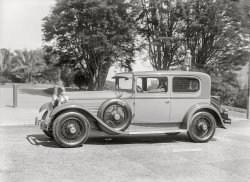
- Colossus: 1902
- ... the rumble of the subways going back and forth through the night. I would peer into the passing cars and wonder who they were and what ... Posted by Dave - 08/01/2012 - 5:31pm -
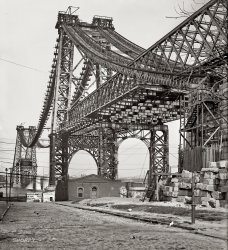
- Morris Hurowitz: 1909
- ... that when he was an adult, he took high school classes at night and correspondence college classes but was never able to get a degree. ... Posted by Dave - 10/08/2009 - 9:44pm -
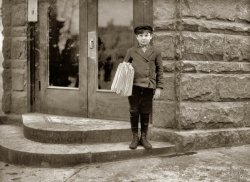
- Jupiter's Darling: 1954
- ... Your Breath! On one of the evening news programs last night in NYC, there was an interview (from some years ago) with Esther ... Posted by Dave - 06/07/2013 - 9:23am -
![Jupiter's Darling: 1954 Esther Williams, star of silver screen and swimming pool who died yesterday at age 91, shown filming a scene for the underwater epic "Jupiter's Darling" in 1954. Photo by Earl Theisen and Robert Vose for Look magazine. View full size.
June 24, 2013 [error]A full day of films by Williams on TCM.
CORRECTION: June 13, 2013 at 8:00 PM eastern time.
Sorry, glad I caught it in time!
Hydro TestingOK, that makeup and lipstick pass the waterproof test!
MusculatureNot in the statue, but in the gorgeous human: biceps and shoulder of right arm, taut right thigh, toes of right foot curled under metal apparatus, pointed left foot. Thank you, Dave, for noting the passing of this beautiful and elegant woman. (And, tterrace, for breaking the news yesterday in the comment on the pool photo.)
Fullback to Esther's backThe role of "Principal Swimming Statue" was credited to John Olszewski, perhaps the California football player who had recently been drafted by the Chicago Cardinals.
Hold Your Breath!On one of the evening news programs last night in NYC, there was an interview (from some years ago) with Esther Williams. She related, in a very modest way, that she had the uncanny ability to hold her breath for long periods of time with very little effort.
Makes sense.... as you can see from the photo, she is very calm and relaxed. A natural ability put to a wonderful, entertaining use.
RIP, Esther! The heavenly pool is all yours today!
Beautiful!Just about the most beautiful total woman on the planet.
Million Dollar MermaidThe lovely Ms. Williams was Louis B. Mayer's answer to Sonja Henie. She had made the 1940 Olympic swimming team, but the Olympics were not held because of the war. MGM built a $250,000 pool to film her.
RIP EstherAnother actress from the Golden Era of Hollywood gone. God bless Esther Williams.
(LOOK, Movies, Swimming)](https://www.shorpy.com/files/images/SHORPY_00757u1.thumbnail.jpg)
- Angels Flight: 1960
- ...
Age of Aquarius I was catching up with my DVR last night, watching the second hour of "Aquarius." Det. Hodiak (David Duchovny) has ... Posted by Dave - 06/02/2015 - 12:16am -
![Angels Flight: 1960 October 2, 1960 "Lower station, 'Angels Flight,' Third & Hill streets, Los Angeles. Last remaining cable railway in the City of Los Angeles." 5x7 acetate negative by Jack Boucher for the Historic American Buildings Survey. View full size.
Angels Flight 2010It has been restored and placed in a different location.
I took this picture in late 2010, the cars weren't running at that time due to an accident some years earlier, and they still aren't as far as I know.
Added Fame"Angels Flight" is the setting for the start of a good detective novel by Michael Connelly.
Age of AquariusI was catching up with my DVR last night, watching the second hour of "Aquarius." Det. Hodiak (David Duchovny) has a large print of this very photo hanging in his office at the Hollywood Precinct in 1967. The ep aired May 28 and this was posted on Shorpy June 2. Coincidence?
Elks Flight?I notice the gate carries the abbreviation B.P.O.E., which stands for Benevolent and Protective Order of Elks (or "Best People On Earth", as my Elk-member grandfather was always fond of saying). So, what was the relationship between this tiny little railroad and a major fraternal organization?
[The local Elks Lodge building was at the top of Angel's Flight. In 1909, seven years after the funicular was built, the lodge paid for the fancy arch at the bottom. -tterrace]
Kookie, Kookie Lend Me Your CombThe fellow on the right, waiting to cross the street looks like a walking ad for Brylcreme or Wildroot. Perhaps Fop or Dapper Dan.
Same location for nearly 20 years!The 2010 photo shows Angels Flight rebuilt and relocated; that happened in 1996. Note the difference in the trackway. The cars used were original.
Since 1996, major accidents have been attributed to poor/neglected maintenance and pure stupidity on the part of management. Kids could fall off the car ends, too. Take the stairs and get some exercise, or check out the nearby Grand Central Market.
Criss Cross (1949)I believe just to the right of this photo is 215 N Hill St., which was a large house that was Burt Lancaster's mother's house in this movie. Burt is seen walking up the hill with the tunnel visible in the background. The tunnel and hill were removed in 1955. The corner figures into the storylines of several movies:
http://www.electricearl.com/bh/
(The Gallery, HABS, Los Angeles, Streetcars)](https://www.shorpy.com/files/images/SHORPY-011992pu.thumbnail.jpg)
- Florida Souvenirs: 1906
- ... variety. They also like different parts of the day and night.
Location This postcard gives the location as South Beach between ... Posted by Dave - 08/29/2012 - 8:33pm -
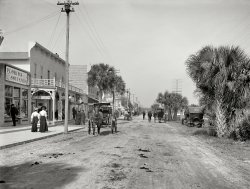
- Ambulance Depot: 1917
- ... insistent has the call of duty become of late that every night four or more members sleep on cots in the garage, ready for emergency ... in case of need, is Franklin 1572. The garage is open day night and day, in the corps wishes it known that any needing ambulance need not ... Posted by Dave - 08/07/2012 - 10:27am -
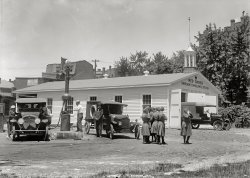
- People's Drug No. 7: 1920
- ... circa 1920. "People's Drug Store, 11th & G streets, night." National Photo Company Collection glass negative. View full size. ... Posted by Dave - 08/03/2012 - 5:50pm -
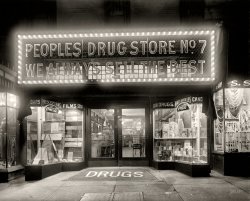
- Laura Mine: 1908
- ... You wouldn't mess with any of those boys on a Friday night!
(The Gallery, Kids, Lewis Hine, Mining) ... Posted by Dave - 07/27/2012 - 10:07am -
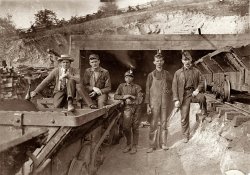
- Student Body: 1925
- ... been a real dilly ~ like coming in after hours on a week night! They were tough, and meant it! This could explain her presence in a room ... Posted by Dave - 05/17/2014 - 11:55pm -
![Student Body: 1925 Washington, D.C., circa 1925. "Homeopathic Hospital." And the leg bone's connected to the knee bone ... National Photo Co. glass negative. View full size.
Those Were the DaysWhen nurses looked like nurses. Now they look like janitors. Star Trek had it wrong. We are not all going to end up wearing one-piece jumpsuits everywhere, we are all going to be wearing pajamas 24/7 in a few years.
Lesson oneThe head bone's connected to the neck bone, the neck bone's connected to the shoulder bone ...
They're all going to die from that mold on the wall anyway.
That's Progress?Wow, I remember those clean-cut outfits nurses once wore. Nowadays you can't tell the nurses from any person off-the-street walking through the hospital.
The Student BodiesA wonderful Army nurse stopped some bleeding on me as a teenaged Marine 44 years ago and all I have to say as a fellow getting on in years is that I love all these bodies. These gals were on a mission to relieve suffering and I tip my cap to them although I understand I'm saluting the past.
High pencils and lovely ladiesI wonder why the pencil sharpener (or was it a chalk sharpener?)was mounted that high?
But that aside, I have nothing but the greatest admiration for the nursing profession. I've only ever stayed in hospital once (so far!) as an adult - emergency appendectomy at age 53 - and fell in love with every one of the (female) nursing staff who tended me. They care about caring.
Pay attention!"Young man, how will you ever get abywhere if you don;t keep up! You can clearly see I am pointing at the elbone."
Grey BlouseI wonder why the very good looking young lady in the center wore a non-white blouse?
[All the rest are wearing those as well; what she doesn't have is the upper part of the apron covering it, for some reason. - tterrace]
InstructionI'm guessing, from its thickness, that the instruction manual for the pencil sharpener must be written in multiple languages
Not that long agoThat nurses looked like this. I distinctly remember nurses dressed this way in the late 70's. Somewhere along the line they decided to change over to medical scrubs. What a shame. I enjoyed looking at the legs of the pretty young nurses when I was in the hospital due to a knee injury.
Re: Grey BlouseYou will also note she is not wearing her nurse's cap.
Likely a younger student, not yet entitled to the full uniform. The only other without cap looks like a doctor, observing the session.
Walletectomy"Watch carefully. It is critical that you understand that the wallet can be found in this general location on the adult male. You can expect to assist the doctor in many wallet extractions in the typical modern medical practice."
Re: re: grey blouseThe young lady in full student uniform at the board with the pointer is likely answering questions posed by the instructor, whom I bet is the older lady in the white uniform sitting close to the front of the room. She may actually be wearing her cap, but the angle of her head and the style of her cap could be obscuring it. If she did not graduate from this hospital's nursing school, but came here later to work, her cap could be different from the other students. If you look very closely behind her left ear, it looks like a small portion of something white is peeking out.
As for the student nurse in a seat at the front of the room, not wearing the bib to the apron, or a cap ~ it's possible that not wearing those items is a punishment for some infraction of the very stiff rules under which the students lived. They lived in a Student Nurses Home or residence on hospital grounds while training, under the sharp eye of one or more House Mothers. They had pretty strict conditions under which they had to behave, and punishment varied according to the infraction. Taking away the cap, once it had been awarded, was a real humiliation for many, and could be applied for several months. Even being caught smoking while in uniform, or while in the dorm itself could have been grounds. If the bib went along with it, it could have been a real dilly ~ like coming in after hours on a week night! They were tough, and meant it! This could explain her presence in a room full of apparently advanced students.
(On closer examination, there may be another student nurse caught with her hand in the cookie jar. In the back row, far left, there seems to be another case of attending class sans cap and apron...she looks like she's trying to duck behind the student in full uniform in front of her when the picture was taken.)
(The Gallery, Medicine, Natl Photo)](https://www.shorpy.com/files/images/SHORPY_32055u1.thumbnail.jpg)
- Big Fun: 1928
- ... last year because they have a very popular swing dance night in the ballroom. The Spanish Ballroom (which is seen in the map) is ... Posted by Dave - 09/03/2012 - 6:49pm -
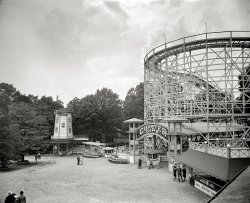
- White House Kitchen: 1909
- ... being president now, sneaking down in the middle of the night to fry up a midnight snack in the same pan used for Taft's ... Posted by Dave - 07/23/2012 - 3:36pm -
![White House Kitchen: 1909 The White House kitchen circa 1909. Note the high-tech light fixture. Harris & Ewing Collection glass negative, Library of Congress. View full size.
Whose Ware?Farberware or pre copper base Revere Ware ?
An interesting link below stating that this photo (looks almost the same) is from the 1909 Taft Administration.
http://www.whitehousemuseum.org/floor0/kitchen.htm
It is also looking like some of the original cookware has survived to modern times. Imagine being president now, sneaking down in the middle of the night to fry up a midnight snack in the same pan used for Taft's breakfast...wow. Only now I would imagine you would also need to feed the 8 guys on your Secret Service detail !
Short of Help or Short Help?The work tables appear impossibly short legged, maybe Dave will explain. Also note the coal fired water heating sidearm with the "clinker door".
[Maybe we just don't realize how big the table is. Pixel-wise, its height is 29 percent of its width. If the base of the grinder is a foot wide, which seems about right, the table is nine feet long. Which would make it a bit over 31 inches tall. Same as the work table in my kitchen. - Dave]
Let there be (electric) lightIt WAS high-tech, a thing to be proud of during that era. But you know that.
KitchenwareIt wouldn't surprise me a bit if pots and pans from the Taft administration were still in use at the White House. Apparently they still use pots and pans from the reign of Queen Victoria at Buckingham Palace (each piece is stamped with a coat of arms from the reign in which it was acquired). However I doubt that President Obama will be sneaking down to fry up some bacon and eggs for himself and his Secret Service detail. Back in the 1961 makeover, a bedroom was converted into a small family kitchen (though I thought that had occurred during the Eisenhower administration).
(The Gallery, D.C., Harris + Ewing, Kitchens etc.)](https://www.shorpy.com/files/images/14658a.thumbnail.jpg)
- Rail Disaster: 1933
- ... River], just inside the District. All day and all night the crews of railroad men worked, first with acetylene torches to clear ... Posted by Dave - 07/02/2014 - 8:18pm -
![Rail Disaster: 1933
GRAVE OF MUD
WASHINGTON, Aug. 25, 1933 -- While thousands worked to overcome the havoc wreaked by the storm in the Capital, 300 trainmen struggled with the wreck of the Crescent Limited. The crack extra-fare express was hurtled yesterday from the tracks of the Pennsylvania Railroad when flood waters undermined the central abutment of the bridge over the Eastern Branch [Anacostia River], just inside the District. All day and all night the crews of railroad men worked, first with acetylene torches to clear debris from the approaches to the bridge, and then with three cranes to lift aside the wrecked cars. Late in the evening a derrick lifting the crushed engine from a grave of mud uncovered the body of the engineer, Arthur H. Bryde, of Washington. The body of J.H. Faye, the fireman, of Havre de Grace, was recovered earlier in the day. It had been ground into the mud of the embankment by a coach.
August 1933. Washington, D.C. "Crescent Limited train wreck." Another look at this wreck. Harris & Ewing Collection glass negative. View full size.
Men dead; locomotive saved.It's a K-4 Pacific type, seen many times on this site. Don't know what number it is, but it was definitely rebuilt. The first K-4 to be scrapped was #8309 in 1938, after a different wreck which occurred in Pittsburg when it plummeted off a high fill and then dropped another fifty feet over a concrete retaining wall into one of the city streets. The leading truck of the K-4 seen above is sunk in the mud dead-center of the photo.
Wrong truckOn a railroad, a truck is the assembly of wheels, springs, brakes, and centering devices which ride on the rails, supporting and guiding the car or locomotive it supports.
The engine is unmistakably, as pointed out, a Pennsylvania Railroad K-4 class 4-6-2 Pacific.
But, neither of the two trucks visible near the center of the photo came from that engine. K-4 pilot trucks were inside bearing. Perhaps, these were from under the tender, or from one of the passenger cars.
Re: Wrong TruckI stand corrected; how I missed them being outside bearing I have no idea. They probably are from beneath the tender, as the lead truck there is missing. Doubt they're from a car, as those appear to be all heavyweight equipment with six-wheel trucks.
LocomotivesWasn't the "Crescent" usually pulled by a Southern RR locomotive?
PRRA Southern 4-6-2 would pull it south of Washington. Guess this wreck must have been at the PRR bridge at 38.917N 76.9435W, where a PRR engine would pull the train.
Re: Re: Wrong truckThey are definitely Tender trucks. PRR Class 2D-T4 to be precise.
Crescent Question"Wasn't the "Crescent" usually pulled by a Southern RR locomotive?"
The Crescent Limited operated from New York to Washington on the Pennsylvania Railroad, on the Southern Railway from Washington to Atlanta, on the Atlanta & West Point / Western Railway of Alabama from Atlanta to Montgomery, AL, and on the Louisville & Nashville from Montgomery to New Orleans.
This particular train would have originated in Penn Station behind an electric locomotive (probably a PRR P5). PRR steam replaced the electric in Wilmington, DE; a Southern Railway Ps4 would take over in Washington (there may also have been an engine swap midway to Atlanta in Salisbury, NC). In Atlanta, WofA 190 or A&WP 290 (which were purchased specifically to haul this train) would take over, and an L&N locomotive would the train on the final leg of the journey.
(The Gallery, D.C., Harris + Ewing, Railroads)](https://www.shorpy.com/files/images/SHORPY-37162a.thumbnail.jpg)
- Dramatis Personae: 1920
- ... play in the offing, and vaguely recall having plans every night that month. (Oh, and: Ouch. ) 8x10 inch glass negative, Harris & ... Posted by Dave - 08/23/2014 - 7:46pm -
![Dramatis Personae: 1920 Washington, D.C., circa 1920. "Iden, V. Gilmore, Mrs." We sense a charity play in the offing, and vaguely recall having plans every night that month. (Oh, and: Ouch.) 8x10 inch glass negative, Harris & Ewing Collection. View full size.
Virginius and AramintaThe V in her husband's name stood for Virginius, and her first name was Araminta -- Araminta Thompson Iden, to be specific. She appears to have been one of several Araminta Thompsons born in the 19th century.
Ouch indeedThat poor woman's feet!
The lady at the top is cute.She'd be cute even today.
Re: Ouch IndeedYup. Shoes 2, feet 0.
Gypsies, vamps and sleevesI do hope that's some sort of stretchy shoe 'vamp' and not actual leather squishing her feet into horrible distress.
Wardrobe malfunctionTypical of an amateur drama group without a budget, the Sultan, all dressed in white couldn't afford matching white shoes so he tried to cover his dark shoes with liquid white shoe polish. It didn't quite work.
[These aren't people who couldn't afford things. -tterrace]
3 poundsof foot in a 2 pound shoe.
Foot bindingI've noticed in my family photos of my young grandparents in the late '20's that the foot bulge was quite fashionable for women. The Shorpy photos of the same period raised my memory of this style and reminded me of why my Grandma's feet were so distorted. Early Popeye cartoons showed Olive Oyle with the same "foot cleavage" but this lady has taken it to the extreme.
False feet?I believe JohnHoward has it nearly correct about a "vamp". However, it doesn't seem to be part of the shoe, and I think it's more likely a costuming device (probably "flesh colored") designed to make it look as if the shoes are severely squishing her feet. On the right foot (on the floor) you can clearly see a piece of cloth(?) attached to the "vamp" and going around the ankle just above the back of the shoe.
[Um, that's the heel of the lady's stocking. Which is indeed "flesh-colored cloth." -Dave]
Pirates and Sultans and Vamps, Oh My!Local drama was quite popular in the 20's. Although I can't quite tell if the man and his two ladies (background), are supposed to be pirates or Gypsies.
Love the shoe bulge too.
(The Gallery, Harris + Ewing, Portraits)](https://www.shorpy.com/files/images/SHORPY-18472a1.thumbnail.jpg)
- Götterdämmerung: 1942
- ... an ending. A better title might be: "Nacht und Nebel" or Night and Fog.
[Twilight of the Gods = the fast-approaching final days of ... Posted by Dave - 07/27/2015 - 12:51pm -
![Götterdämmerung: 1942 December 1942. "Chicago, Illinois. Repair and overhauling in the Chicago & North Western Railroad locomotive shops." Medium-format negative by Jack Delano for the Office of War Information. View full size.
Franklin BoosterLooking in the lower left corner of the photo, the item on the cart is a Franklin Booster. These were mounted usually on the rear truck of larger steam engines and provided extra tractive effort at lower speeds. The SP 4449 has one.
Flooring: bricks or wood blocks?The flooring may be wood blocks set on end, rather than bricks or stone blocks. I've seen this in another roundhouse, the reasons for using wood were (a) absorb oil, rather than providing a very slippery surface for oil spills, (b) less chance of damaging a part if it were dropped.
GötterdämmerungI see what you did there... :)
Twilight of the GodsWhen exactly does the fat lady sing?
Wood blocksDuring the late 1920's and early 1930's my father was the engineer who was in charge of the Brooklyn Bridge. He told me that the bridge was paved with wooden blocks set on end very much like the railroad shop in the picture. . When the blocks became worn they were picked up and turned over. Relatively light weight, non-slippery and durable.
Wrong TitleAlas, Götterdämmerung is an ending. A better title might be: "Nacht und Nebel" or Night and Fog.
[Twilight of the Gods = the fast-approaching final days of the huge steam locomotives which up to this point had ruled the rails unchallenged. -tterrace]
Various AppliancesA poster below already pointed out the booster engine on the closest track. Good call; I had no idea what it was. The cylinders on the floor to the right of the booster are interesting. I want to say that they're compressed air reservoirs, but they appear to be way too long, so I have no idea.
Lead and trailing trucks are being worked on tracks 2 and 3. There's a 2-wheel pony (leading) truck on track two that is flipped over. To the right of that is a 4-wheel trailing truck off a 2-8-4. The trailing truck on track 3 that the guy is welding inside is off an H Class 4-8-4, pictured many times on Shorpy. Neither locomotive is in the picture. Perhaps if we turned the other way? The picture looking the other direction is on here someplace.
Great Delano exhibit in Chicago going on nowJust visited the Jack Delano "Railroaders" exhibit at the Chicago History Museum. The exhibit focuses on the people who insured that America's WWII railroad supply lines ran efficiently and at full capacity. Great photos (black and white AND COLOR!) of dozens of railroaders, from top management down to the gofers. Terrific insights into the dispatching and maintenance of the trains and great stories of the folks and families who depended on railroading as a livelihood. Lots of train photos, too. If you are a fan of Jack Delano's art or a fan of mid-20th century railroading, don't miss this exhibit. It runs through the end of January 2016.
(The Gallery, Chicago, Jack Delano, Railroads)](https://www.shorpy.com/files/images/SHORPY-8d23858a.thumbnail.jpg)
- Walter's Restaurant: 1953
- ... breakfast menu. There was usually a dinner special each night, something like roast beef or fried chicken. The "diet plate" consisted ... Posted by Jack Gorham - 08/06/2017 - 6:11pm -
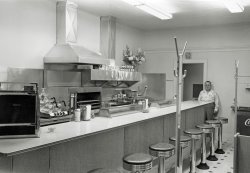
- Ask a Teenager: 1922
- ... were heard across the Atlantic in the course of a single night.
A Question About Shoes Looking at these images, I am always ... Posted by Dave - 07/23/2012 - 10:53am -
![Ask a Teenager: 1922 Washington, D.C., circa 1922. "William Armstrong Perry." A former editor of Boys Life and Scouting magazines, W.A. Perry authored a study called "Radio in Education." National Photo Company Collection glass negative. View full size.
Schooled by RadioIn the Canary Islands, where I live, a local, non-for-profit radio station (Radio ECCA for anyone curious enough) did a great job teaching to write and read, as well as finishing elementary and high school education to adults who never had the opportunity to get an education or were forced to leave school at an early time. It's still in operation, though now its focus has changed.
Crystal Radio The radio is a crystal set receiver (not a transmitter), probably a Westinghouse Aeriola Jr. Model RE. Crystal sets, which preceded tube radios, operated without batteries or any other power source. They required a long wire antenna and an earth ground connection to receive AM broadcasts.
[What's the mouthpiece for? - Dave]
Seizing Music Out of the Air Although a bit optimistic concerning the speed of development, in 1921 Mr. Armstrong Perry accurately predicted the development of cell phones: "The demonstration ventured to prophesy that the day was at hand when by means of a simple pocket apparatus one could call up his home and talk without wire from almost any distance, and there was none dared call him a dreamer! "
Washington Post, Dec 18, 1921
News of Boy Scouts
At the monthly meeting of the Scoutmasters club, held in Epiphany parish house last Tuesday evening, modern achievements in wireless held the center of the stage. Through the courtesy of Mr Armstrong Perry, the latest apparatus in telephonic communication without the use of wires was demonstrated. When a little equipment, most of which could be carried in a suitcase, was set up in the room, and after slight adjustment began reproducing a concert that was taking place in another part of the city, the effect was distinctly spooky. Even men used to transcontinental telephonic communication were abashed at this exhibition of seizing music out of the air and amplifying it until all in the room could enjoy it; without receivers to their ear, without even the outside wires running high over head, to which the radio operator is accustomed.
The demonstration ventured to prophesy that the day was at hand when by means of a simple pocket apparatus one could call up his home and talk without wire from almost any distance, and there was none dared call him a dreamer! So rapid have been the strides in the last few months in radio that no prophecy seems extravagant. Only a few weeks ago eighteen American amateur stations were heard across the Atlantic in the course of a single night.
A Question About ShoesLooking at these images, I am always drawn to the shoes. How often these days do you ever see shoes that are this worn? I always wonder how many shoes a typical adult would have had in their wardrobe and how many siblings would wear the same pairs.
[Indeed. Feet and shoes seem to hold a certain fascination for the Shorpy commentariat. - Dave]
Worn or just poorly maintained?A good cleaning and some polish and those shoes would look a whole lot better. Soles and heels don't look worn, although the angle is not the best.
Good question about those shoes.I'm glad to see a photo of William Armstrong PERRY, who is my 1st cousin 3 times removed, here on your website. I'm informed that he was always quite interested in scouting; collecting coins; studying radio communications (fairly new at that time), traveling to the relatively unknown places of the world, and was a writer as well. He married a woman named Lulu MONTANYE who was a writer as well (articles for McCalls amongst others, and a few short stories). She was quite a 'liberated' woman for those times and remained quite interested in many of her husband's endeavors, including his radio hobby.
To me, the cut of those shoes, the cut of the hair, the petite hands, make me wonder if this is William's wife, and not a boy interested in radio as the information provided here implies. Do you have more information on who is pictured in the photo?
Also, if the photo was taken at William's home, then it would have been either at their home in Addison, New York, or their home in Westport, Connecticut.
William Armstrong Perry survived a plane crash and spending 15 days in the Venezuelan Jungle in May 1837. He died on July 5, 1938 at his Westport home of a heart attack. Some say the heart attack was a result of lingering injuries from the plane crash. Lulu lived until 1966. Both are buried near the home of their childhood at Canton, Bradford Co, PA.
(Technology, The Gallery, D.C., Natl Photo)](https://www.shorpy.com/files/images/30168u.thumbnail.jpg)
- Hop In: 1919
- ... the morning meal. Each has a job in New York.
At night they wend their respective ways home to 11 Vandam street. After ... Posted by Dave - 08/28/2012 - 3:10pm -
![Hop In: 1919 Washington, D.C., circa 1919. "Mrs. Marsh, Mrs. Boeckel." Eleanor Taylor Marsh and Florence Brewer Boeckel of the National Woman's Party. View full size.
Cool RoadsterLooks like two nice women out riding in their sporty little two seat roadster. What is that car anyway?
V for victoryA card in the window on the right appears to say "V [for] Victory." I'm surprised, I thought that was a World War II slogan.
I am old but...I have been married twice and never wanted to be called "Mrs." How times have changed! Love the pic.
Miss Eleanor TaylorMiss Taylor appears to have dropped her early insistence on retaining her own name in marriage. I hope she wasn't so easily swayed to abandon other progressive notions she espoused. The following article is striking for the tone of wonder at a marriage based on equal partnership. Additionally, its hard to imagine a contemporary reporter questioning a woman about birth control.
Washington Post, Feb 21, 1917
Pretty Vassar Girl Keeps Own Name
As Party to "Individual Marriage."
Bride and Bridegroom Pay Share-and-Share-Alike for
Everything from Laundry to Movie Tickets
"Mr. Marsh and Miss Taylor" is Legend on Doorbell.
New York, Feb 20. — Pretty 21-year-old Eleanor Taylor, as attractive a girl as ever helped carry the daisy chain at Vassar College, has given prosaic Greenwich Village its latest excitement. From the quiet of the halls of the ancient seat of learning she has walked with bold and undaunted step into the very center of the "village" Bohemians. What has she done? She has entered into the latest of marital contracts with Benjamin Marsh, war correspondent, radical and seventeen years her senior, in what now becomes famous as the "Individual marriage."
The "individual" clause of the contract was added when Miss Taylor and Mr. Marsh — not Mr. and Mrs. Marsh — found themselves sipping tea in the cheerful home they had previously fixed up in the environs of Washington square.
In a word, the clause that makes a marriage in "individual" one is nothing to be scoffed at by the struggling artist who finds both ends hard to meet. True, it robs him of what many men glory in — dominion over his spouse — but it makes life less worrisome. It seems that the wife is to retain her individual rights, including everything. She does not even have to give up her name, her position, her thought, her work; nor does such a marriage permit a husband to support his wife. She supports herself, and Miss Eleanor Taylor and Benjamin C. Marsh are carrying their contract out to the letter. Each contributes equally toward the morning meal. Each has a job in New York.
At night they wend their respective ways home to 11 Vandam street. After comparing expenses for the day they go over to the Greenwich Settlement House, where they dine sumptuously for 35 cents each. As they stop at the cashier's desk on the way out, Miss Taylor pays her own check, Mr. Marsh his. To the "movies," a lecture or the theater, Miss Taylor pays for her ticket. Mr. Marsh pays for his.
"I met Mr. Marsh a year ago at the Greenwich Settlement House," said she. "Neither of us wanted to impose his belief on the other. We agreed in purpose, though. We decided on our mode of living, because we knew it would make us happier; all the more because each has his own work. We decided that each contribute to the support of the household. We figure out the cost of breakfast — just now it is 15 cents — and we divide the amount. We pay our laundry and other bills separately. No man, husband nor anyone else could make me change my individual thinking, and my name? On our doorbell we have Mr. Marsh and Miss Taylor."
"Do parties in individual marriages believe in birth control?" asked the interviewer as a final question. "I do," said Miss Taylor, frankly, as she bent over her desk to resume her work.
Washington Post, Dec 9, 1968
Eleanor T. Nelson, Crusader, 73, Dies
Eleanor Taylor Nelson, 73, an early crusader for women's suffrage, died yesterday at George Washington University Hospital after a stroke.
Mrs. Nelson was a publicist for the National Woman's party, which was instrumental in getting Congress to pass the 19th Amendment in 1919. In the early 1920s she was a public information officer for the U.S. Children's Bureau and was a founding member of the Women's National Press Club.
Mrs. Nelson moved to New York City in 1927 and worked for many years as a copy writer for the J. Walter Thompson Co. advertising agency.
She was married to the late Benjamin C. Marsh, the late Horace Wylie and the late Ralph Nelson. She returned to Washington several years ago and lived at 2101 16th st n.w.
She is survived by a son, Michael Marsh, of Washington; a daughter, Mrs. Wallace Scott, of Bennington, Vt.; a brother, James I. Taylor, of Philadelphia; two sisters, Mrs. Ira Keller, of Portland, Ore. and Mrs. George K. Hourwich of New York City, and five granddaughters.
The caris a Reo.
Florence Brewer Boeckel
Washington Post, Oct 17, 1965
Florence Boeckel, 79, Suffragist and Editor
Florence Brewer Boeckel, a crusader for woman suffrage, who was an education director of the National Council for Prevention of War from 1921 to 1935, died early Saturday morning in Mar-Salle Convalescent Home, She was 79.
Mrs. Boeckel was born in Trenton, N.J., and graduated from Vassar College in 1908 before doing graduate work in Paris and Dresden. In 1910 she became a special investigator in the Poughkeepsie, N.Y., schools, and in 1911 joined the Poughkeepsie News-Press as a feature and editorial writer.
She was on the editorial staff of Vogue magazine in 1911 and 13 and was a feature writer for the Baltimore Sun in 1914 and 15. Between 1917 and 1920 Mrs. Boeckel was the publicity director of the National Woman's Party, aiding their drive for suffrage and from 1919 to 1920 she edited The Suffragist.
Mrs. Boeckel wrote two books: "Across Borderlines," 1926 and "Between War and Peace," 1928. Two earlier books, "Study of Occupations Open to Young Women" and "Through the Gateway," were published in 1911 and 1920.
In the 1930s Mrs. Boeckel wrote a weekly newspaper column called "Between War and Peace," and in 1936 was American delegate to the World Peace Congress in Brussels and attended the opening session of the Council and Assembly of the League of Nations in Geneva.
Mrs. Boeckel also was a founding member of the Women's National Press Club. She is survived by her husband, Richard, of the home at 2137 Leroy pl., nw., and by a son, John Hart of College Park Woods Md.
Washington Post, Jan 11, 1916
Licensed to Marry
...
Richard M. Boeckel, 24, Pittsburgh, Pa., and Florence M. Brewer, 30, Washington. The Rev. E.S. Dunlap.
...
REO AutomobileThe car is a 1916 - 1918 REO Four Passenger Roadster which cost $1250 in 1916. By 1918 the price was $1550.
For comparison, a Model T Runabout (2 Door) base price was $345 in 1916 and $500 in 1918. A Packard 2 Door Passenger Coupe was $2,700 in 1916 and $3,450 in 1918. Prices went up because of WWI and post-war inflation.
The REO is a six cylinder model. A Ford Model T is only a four cylinder engine and the Packard is a 12 cylinder.
The radiator with the front sloping forward is unique to REO. The 1918 REO slogan was "The Gold Standard of Values." The illustration below is from their 1916 Prestige brochure.
(The Gallery, Cars, Trucks, Buses, D.C., Harris + Ewing)](https://www.shorpy.com/files/images/12177a.thumbnail.jpg)
- Fresh Picked: 1939
- ... fella. Maybe they're just friends, and it's a Saturday night early date?
Hang On! Soon enough, there'll be plenty of jobs in ... Posted by Dave - 02/24/2013 - 2:27pm -
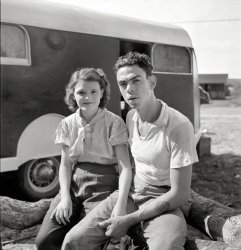
- Military Exercise: 1917
- ... or had a wee bit too much booze at the dance hall last night! I see KP duty in his future...hee hee!
"If we ever fight the ... Posted by Dave - 08/07/2012 - 11:05am -
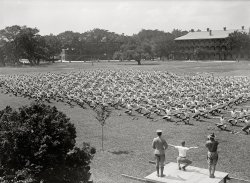
- Boston Market: 1909
- October 1909. "Late at night. Boston market. Many young venders." 5x7 glass negative by Lewis Wickes ... Posted by Dave - 06/06/2016 - 4:51pm -
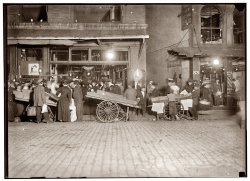
- Idlers: 1916
- ... that his last name is Hine. Not Hines. Thank you and good night. - Dave]
Cyran and who? Trying to read the cafe sign in the ... Posted by Dave - 10/01/2008 - 10:48am -
![Idlers: 1916 June 29, 1916. Chicopee Falls, Massachusetts. "Hanging around the saloon -- 5 p.m." Photograph by Lewis Wickes Hine. View full size.
Boys on the Stoop"Range in age from 18 to 65. After working 10-12 hours at mill, cannery and factory, repair to the saloon for alcoholic beverages at 5 o'clock on a Monday afternoon. All said they had been doing this since they were old enough to see over the bar. Most smoke. Whites sociliaze frequently here with Negroes and Italians."
I love these guys!They worked hard and they played hard. Stopping at the gin mill after work to "turn over a few" was a ritual and I well remember my uncle and his friends ending the workday with a drink or two and an (illegal) street game of shooting craps for pennies. The police would just tell them to go home and move on. Those "bucket of blood" saloons had signs in the window saying they had "tables for ladies" but no lady ever entered therein. Sometimes when the playful shoving and pushing got out of hand (i.e. that guy falling off the stoop) a real fist fight would break out, there would be blood, usually from noses, and the next thing being heard as someone was dragged away was "Did he have a hat?" A GREAT and unexpected scene from my childhood. Thank you for this unusual photo to bring it all back.
Outdoor TypesMy friends and I used to go inside.
Shake On It!Looks like the dapper young thing in the white shoes doesn't want to get his pants dirty, so he is sitting on a towel. Sort of out of place with this rough-and-tumble crowd. I notice their ale comes from Springfield -- wonder if it's Duff.
The Temperance MovementI wonder what Hines's opinion was on the temperance movement. Do we know? Given his social activism, and some of his comments on alcohol in his various photos of tenement life, one wouldn't be surprised if he were a prohibitionist. Indeed a photo like this would have been just the sort of thing that the Women's Christian Temperance Union would have seized upon in this period in support of the ban on alcohol - men at the bar wasting their money getting drunk instead of taking it home to the benefit of their families (who, the WCTU would insist, were destitute because of booze), associating with unsuitables (Negroes and Italians - the WCTU was very WASPish to the point of not accepting Catholics, Jews, African Americans, or women not born in North America), and getting violent. Whatever Hines's personal opinions, this sort of picture would be just the sort of propaganda piece that the anti-saloon advocates would use.
[As LWH's PR man here in the 21st century, may I take this opportunity to point out once again that his last name is Hine. Not Hines. Thank you and good night. - Dave]
Cyran and who?Trying to read the cafe sign in the window.... Checking the U.S. census (1910 and 1920) reveals several Cyrans (of Polish-Austrian descent) living in Chicopee, Mass. Most are listed as mill laborers rather then cafe owners. I can't make out the second name of this joint cafe venture. Visually, the best I come up with is "Bjercasinski" which yields no results in a census search (nor Google search for that matter). Any suggestions?
[Twelve letters. Vanna? - Dave]
Grandpa!That guy on the far left looks a lot like my grandfather, who would have arrived in Chicopee Falls about 1914.
(The Gallery, Eateries & Bars, Lewis Hine)](https://www.shorpy.com/files/images/05108u.thumbnail.jpg)
- Off the Rails: 1862
- ... enough to distinctly hear the click-clack of the trains at night through the trees. There's a very interesting site on the history of ... Posted by Dave - 07/21/2012 - 9:17pm -
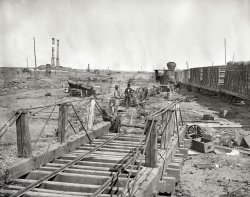
- Wheel of Fire: 1943
- ... Fire explained: Comments from a friend -
Many's the night I supervised that same operation at Enola Enginehouse machine shop when ... Posted by Dave - 08/30/2012 - 11:59am -
![Wheel of Fire: 1943 Re-tiring a locomotive driver wheel in the Atchison, Topeka, & Santa Fe railway shops at Shopton, near Fort Madison, Iowa. March 1943. View full size. 4x5 Kodachrome transparency by Jack Delano.
Fire WheelGreat picture would like to see more RR shop pictures
Delano PictsDid Jack work for the Santa Fe RR, or was he an avid railfan like many of us are especially me? I know you told me that he passed away 10 yrs ago, has his family saved and ever thought of giving his great pictures to Trains & Railfan mags? How were you able to get the photos? I'd like to know more about jack and who he was and how he lived.
[Have you tried the Internets? Google. Wikipedia. - Dave]
Fire WheelThis is an interesting shot but I believe the picture should be rotated 90 degrees clockwise. The heavy steel support illuminated below the flames is a stand that supports the axle and keeps the wheel off the ground. Notice the flames also point to the left (up). Nevertheless, this is a beautiful example of a common maintenance procedure on a steam locomotive. The steel tire is separate from the cast steel wheel center. The inside of the tire is machined several thousandths of an inch smaller than the wheel center. It's heated by fire from a ring of gas pipe. As the tire gets hot, it expands and is then driven onto the cooler wheel center by workmen with sledge hammers. It's then clamped into position and allowed to cool and shrinks tightly on the wheel. Jack Delano's photography captures the essence of railroading of this era with elegance and sensitivity.
[The wheel has been rotated. Below, a clearer view of the procedure. - Dave]
This process was also knownas "sweating" on a tire.
These series of photos are fantastic!
Ring of Fire explained:Comments from a friend -
Many's the night I supervised that same operation at Enola Enginehouse machine shop when we sweated new tires onto the P5 wheels. (GG1s had smaller wheels with tires but those were all done at Wilmington.)
The trick was, after the wheel cooled down to room temp. (after removing the tire) you had to measure WITH A MICROMETER, the outside diameter of the wheel to .001 inch. Then you had to measure the inside diameter of the tire also to .001 inch. As if that wasn't difficult enough, if it was cold outside and somebody opened the barn door the tire or wheel could change diameter and blow the entire exercise.
If the tire was too large, we had to choose the correct thickness of shim and insert it between the tire and the wheel while heating the tire with a flame.
Today that is all a lost art. Occasionally we'd get the tire too tight on the wheel and it would snap. Also tires would come loose during service. If the inspector suspected a tire was loose, he'd put a chalk mark across the tire and wheel and watch it when it came back onto the pit and see if the chalk line still matched up.
The P5s and GG1s didn't have dynamic brakes so the enginemen rode the independent brake a lot on the downgrades.
WDV
(The Gallery, Kodachromes, Jack Delano, Railroads)](https://www.shorpy.com/files/images/1a34708u.thumbnail.jpg)
- New England Terminal: 1957
- ... left of the picture. I'm guessing it lit up blue at night like ours did. Wouldn't it be nice to go back there, even for a day?
... Posted by Dave - 07/21/2015 - 12:24pm -
![New England Terminal: 1957 "Street scene, Providence, 1957." Featuring the New England Terminal Co. bus station, Chicken Roost restaurant and Journal-Bulletin newspaper building. 35mm negative, photographer unknown. View full size.
Nostalgia attackJust look at all those solid, chrome-enhanced, built-to-last American cars! Before I got my own car, I also used to ride buses just like this to get to work and back every day. At the time, I still lived at home in Ct., the second smallest state, and only Rhode Island was smaller, but both states were heavily industrialized and people worked, hurried everywhere and rushed around just like in the biggest cities, with never an idle moment. I also like the art deco vertical bus station sign on the extreme left of the picture. I'm guessing it lit up blue at night like ours did. Wouldn't it be nice to go back there, even for a day?
GoneDepot gone, Chicken Roost gone, but the handsome building behind remains.
What film?The image is sharp all over but very grainy. If that's a full frame and the negative isn't reticulated, I'd guess it was shot with something like Kodak's Royal-X Pan. Do the edge markings identify the film?
Gilbane ConstructionA Providence-based company, still family-owned with headquarters on Jackson Walkway in Providence. They went on to build the Air and Space Museum, the Vietnam Veterans Memorial and the World War II Memorial, just to name a few. A long way from a street corner in Providence.
Gone (comment)Unfortunately, though, the windows of the handsome building have been replaced. They are not an ideal choice (economical, no doubt) and change the character of the building.
BusesThe buses in the picture are intercity buses: in this case Providence to nearby New Bedford. Meanwhile, the city transit at this time was the fabulously luxurious UTC system, second only to the Registry of Motor Vehicles in its ability to torture and befuddle the good citizens of Rhode Island. A typical UTC bus of the period is shown. As Mark Twain said "Difficult? Troublesome? These words cannot describe it."
Rain and CarsWhat a great photo--it really gives the flavor of a rainy fall New England day. Cars from left: 57 Chevrolet (around corner); c. 51 Olds; 51 Ford in front of c. 55 Nash Rambler, itself in front of 57 Chevrolet; buses; 46-48 Ford in front of c. 50 Studebaker; 55 Pontiac parked in front of van; 57 Ford parked behind truck.
[The Rambler is a 1957; the 46-48 Ford is either 1947 or 1949 (typo) 1948; the Studebaker is a 1950. -tterrace]
WEAN and WPJBProvidence City Archives has some things to say about the Providence Journal-Bulletin and WEAN and WPJB- FM:
All of these events and developments, the good and the tragic were covered by the Providence Journal-Bulletin, the city's only daily newspaper of general circulation since the demise of the News-Tribune and its successors in 1937-38. The influence of the Journal and its radio affiliates WEAN and WPJB- FM on Providence thought and opinion is perhaps greater now than at any previous time.
Rain and Cars IIThe older Ford is definitely not a 49, as that was the first year of the postwar restyling. If you say 47, I won't argue. Thanks.
[I made a dumb typo, I meant 47-48; you're right, no way a 1949. The difference between '46 and '47-8 is the position of the parking lights. -tterrace]
(The Gallery, Cars, Trucks, Buses, Found Photos, Providence)](https://www.shorpy.com/files/images/SHORPY-BW-026.thumbnail.jpg)
- Family Cart: 1937
- ... go there to listen to the jukebox and guzzle beer.
One night, as we were necking in the front seat of her car in a parking space in ... then motored off into the darkness of the hot and humid night.
I've often wondered what happened to them.
On the Bandwagon ... Posted by Dave - 10/05/2015 - 9:35am -
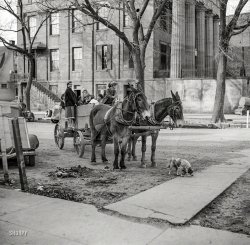
- Blitzen Benz: 1911
- ... & Barnard, at the finish line?
Up too late last night,
mad4books
Spidey? Does he not look just like Tobey Maguire?
... Posted by Dave - 12/10/2007 - 5:38pm -
![Blitzen Benz: 1911 May 25, 1911. Bob Burman and his "Blitzen Benz," a month after setting a world speed record in the car. View full size. George Grantham Bain Collection.
Is today's picture brought to us by the letter B?Did Bob Burman race his "Blitzen Benz" at Brighton Beach?
Was his wife Barbara in the audience? Were his parents, Brunhilde & Barnard, at the finish line?
Up too late last night,
mad4books
Spidey?Does he not look just like Tobey Maguire?
Was his wife's name reallyWas his wife's name really Barbara? I think not
Racer XTo go with the earlier Speed Racer post.
Can't you see the speedlines?
Bob BurmanAt the time Burman set that official speed record, he was the fastest man in the world. Only a bullet or cannon shell was faster - he was twice as fast as any existing airplane, and no locomotive could go faster, either. It was a unique record.
Bob, Brunhilde, Bernard, Barbara BurmanBob's parents were not Brunhilde & Bernard, they were Frances and William. Bob's wife's name was not Barbara. He had two wives, the first Lulu, and the second Helen. I don't believe that either of his parents saw him race out of state, but I'm not sure of that.
[You are still Not Getting It. - Dave]
Wife and parentsHis wife was not Barbara (he had two wives in his lifetime), and his parents, were not Brunhilde & Barnard. I don't believe his parents ever saw any of his races out of state. But that I can't be sure.
[Clueless Comment of the Day! Clapclapclap. - Dave]
(The Gallery, Cars, Trucks, Buses, G.G. Bain, Sports)](https://www.shorpy.com/files/images/09237u.thumbnail.jpg)
- Nighthawk: 1919
- "People's Drug Store No. 2, Seventh and E Street, Night." 1919 or 1920 in Washington, D.C. National Photo Company glass negative. ... Posted by Dave - 07/17/2012 - 10:15pm -
![Nighthawk: 1919 "People's Drug Store No. 2, Seventh and E Street, Night." 1919 or 1920 in Washington, D.C. National Photo Company glass negative. View full size.
What? No Bacon and Eggs?This is from the days when a "drug store" sold medical necessities and health care products, filled prescriptions and recommended patented remedies for "what ails ya", while today's drugstores sell all types of foods and products including everything from plastic lawn chairs to t-shirts to furniture and everything in between.
On this very day, the Walgreen's ad is featuring various canned goods, giftware, film developing, backpacks, batteries, toys, socks and slippers. How times have changed.
[Not much has changed, then. In addition to cigars, Coke and candy, the storefront here is devoted to a mothproofing display. - Dave]
CigarsIf I'm reading it correctly, in the extreme left window, there are Helio's Genuine Manila Cigars, 7 for 25 cents. that would be about 3½ cents each. In 1920, Thomas Reilly Marshall, Woodrow Wilson's Vice President, said "that what this country really needs is a good 5 cent cigar" If you couldn't get a good one for a nickel, we can only imagine what a 3½-cent cigar was like.
So what was the 'new' waySo what was the 'new' way for mothballing. It's too far away to tell what's on display to the right. Those hand-pump fumigators remind me of Tom and Jerry cartoons.
[Something to do with White Tar garment bags, it looks like. - Dave]
Blue LawsI spent part of my youth in a small Southern town. The drugstore was open on Sunday (People's, of course) but certain aisles were blocked because the "blue laws" said you could not purchase certain non-necessary items on Sunday. Even as a kid I found this nuts and wildly inconsistent, as to who decided what was which.
I miss People's. Perfect complement to Woolworth's. Lunch counter and lots of strange old remedies.
The ScaleA penny surely. While the economy might have been good, you wouldn't expect to pay more to find out your weight than you would to buy a cigar.
A mere pennyEven in the 50s/60's when I was growing up these scales were a penny (and still around), so I'm guessing that was the amount.
ScalesThe scales are now a quarter and the fortunes aren't any better.
Health ConsciousWaist watchers could even check their weights on that scale to the left. Wonder how much it cost? In the relatively good postwar economy I'm guessing a nickel.
(The Gallery, D.C., Natl Photo, PDS, Stores & Markets)](https://www.shorpy.com/files/images/28984u_0.thumbnail.jpg)
- I'm Baaaaad: 1920
- ... Roosevelt Longworth. Under the sign "this pig slept last night in the White House," he brokered the sale of a pig for young Quentin ... Posted by Dave - 01/23/2014 - 10:18am -
![I'm Baaaaad: 1920 Sept. 3, 1920. Washington, D.C. "Wap-See-Ho-Hong." We leave it to our resourceful commenters to fill in the blanks. National Photo Co. View full size.
The Horn of a dilemma?Getting "butted" by this fellow would sure be a new twist!
Bad Is Right!Unless my eyes are deceiving me, it appears that this may be the first picture on SHORPY of anything, man or beast, relieving itself.
[That's hay. - Dave]
Baaaad Job!Looks like one of Morning Glory and Oberon G'Zelle's semi-successful experiments!
HmmSomehow the term "animal glue" comes to mind.
Sheep. Why'd it have to be sheep?I'm much better at identifying goats. But it looks like our friend here may be related to a Jacobs Sheep. They have some whackadoodle horns.
Could it be?The fabled ramoceros.
Picture?Who in their right mind would stop, see, then set up the camera to take a picture of something only a mother could love?!!!!
[The National Photo Company was a commercial photography firm which, in the words of the Library of Congress, "supplied photographs of current news events in Washington, D.C., as a daily service to its subscribers. It also prepared sets of pictures on popular subjects and undertook special photographic assignments for local businesses and government agencies." -tterrace]
The Great Wolf Slayer
Washington Post, June 8, 1918.
Masonic Notes
…
Grand Monarch Edward S. Schmid is to take a hand with a curiosity which he found in southern Texas on his recent trip there. It is a handsome goat with the usual accompaniment of side horns, but with a spike sticking from the top of his head which makes him unique. Grand Monarch Schmid calls his pet “Wap-See-He-Hohong,” which he says means “the great wolf slayer.” …
Schmid's SheepEdward S. Schmid (like his father and grandfather, and later his son, Edward L. Schmid), sold small animals a short distance from the White House. He was the proprietor of Schmid's Bird and Pet Animal Emporium at 712 12th Street NW in Washington. He sold snakes to Alice Roosevelt Longworth. Under the sign "this pig slept last night in the White House," he brokered the sale of a pig for young Quentin Roosevelt after the president's son had snuck it into the White House, only to have it discovered. He seems to have been a generous man; he included in his store's catalog instructions for the treatment of rabbits with colic, constipation, sniffles or influenza, and published a phamplet on how he chose his canaries. A freemason and member of associations such as the Association of the Oldest Inhabitants and National Tuberculosis Association, the elder Schmid's donated records take up 25 linear feet in the archives of the Historical Society of Washington D.C.
[Also, this article from the The National Humane Review, October, 1918. -tterrace]
(The Gallery, Animals, D.C., Natl Photo)](https://www.shorpy.com/files/images/SHORPY_02213u.thumbnail.jpg)























